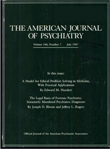The coexistence of parkinsonism-like symptoms and tardive dyskinesia
Abstract
The authors used the Simpson-Angus Neurological Rating Scale and the Simpson Abbreviated Dyskinesia Rating Scale to evaluate 132 psychiatric inpatients for the presence of parkinsonism-like symptoms and tardive dyskinesia, respectively. Ninety-four percent of these patients had been on a stable drug regimen for a minimum of 2 weeks before assessment; 91% were being treated with neuroleptics, 42% with antiparkinson agents, and 7% with tricyclic antidepressants. Tardive dyskinesia and parkinsonism-like symptoms coexisted in 17.4% of the 132 patients. Such coexistence poses a therapeutic dilemma for the clinician because drug treatment of improve one neurological condition may exacerbate the other.
Access content
To read the fulltext, please use one of the options below to sign in or purchase access.- Personal login
- Institutional Login
- Sign in via OpenAthens
- Register for access
-
Please login/register if you wish to pair your device and check access availability.
Not a subscriber?
PsychiatryOnline subscription options offer access to the DSM-5 library, books, journals, CME, and patient resources. This all-in-one virtual library provides psychiatrists and mental health professionals with key resources for diagnosis, treatment, research, and professional development.
Need more help? PsychiatryOnline Customer Service may be reached by emailing [email protected] or by calling 800-368-5777 (in the U.S.) or 703-907-7322 (outside the U.S.).



